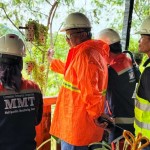Recommends using “Public Sector Share” concept rather than “Government Share”
In the letter addressed to His Excellency President Aquino, TVI Resource Development (Phils) Inc. (TVIRD) President Attorney Eugene T. Mateo offered key analysis and information to the government based on the company’s eight years of mining operations in Siocon, Zamboanga del Norte (and 10 years of exploration in the country before that).
Public Sector Share vs. Government Share:
TVIRD recommended to the government that it may wish to think about the “Public Sector Share” rather than just the more limited “Government Share”.
The reasons are that in the Philippines, companies exploring for, and producing, the minerals that make our world go round, are required to invest significant funds in areas that would, in other countries, be the responsibility of the State, in addition to the normal taxes that are paid to the State. Minerals are found, by and large, in remote, hinterland parts of the country, where there is a palpable lack of development and where, in the main, “the State is absent”, so to speak … where there are few services that are normally provided (in other countries) by the State; where there are no roads; there are no hospitals; there are no schools; there is no police; no security; and very little justice. Because of the relatively high population density in our country (relative to other countries), companies have to provide all these things in place of government, and in so doing are in effect relieving government of having to make expenditures that they would otherwise have to do. It’s taxation by another name – contributing to local government benefits as well as to the national government.
Here are some examples from the case of our company, which operates a copper mine in the hinterland of Zamboanga del Norte, one of the 10 poorest provinces in the country. The project has been operating since 2004, during which time …
- Infrastructure : We have had to devote significant funds to improve – and annually maintain – a Provincial road in order to be able to operate. We have spent approximately P 94 million on provincial road construction and maintenance since 2004 at Canatuan. The road is used by the communities as well as by TVI – facilitating, for example, the first bus service that the municipality of Siocon has ever had.
- Services : Since there were insufficient schools, hospitals or other government services in the mountainous region, we have had to provide all these, over and above the taxes we pay. In addition to the mandated Social Development and Management Plan expenditures of P 68 million, we have also spent P 36.5 million in health facilities, medical personnel and an ambulance service.
- Indigenous People : companies are required to pay a royalty to the indigenous people as landholders. This is, in effect, a tax – amounting to a total of P 164.5 million in the period 2004-2011.
- Security : because of the recent conflict in the area we have also had to spend funds on security to protect both our operations and the community; security that would normally be provided, in other countries, by the State. Importantly, the overwhelming volume of security expenditures is in the employment of local people.
Through our contribution in infrastructure, services and IP royalties, the State has in effect been relieved of having to spend those funds, constituting a contribution by the mining operation to the public sector that is the equivalent of taxation.
The Full Cycle of Minerals Development Investment:
A second part of the media discussion, sorely missing, is the RISK undertaken by companies trying to find the minerals that produce taxes and benefits and the Public Sector share. Even in the minerals-rich Philippines, companies have to kiss many, many frogs before they find their princess.
For example: TVIRD’s numbers that start with the Canatuan mine in 2004 do not reflect the substantial amount of initial exploration investment brought into the country by TVI, not only in Canatuan but in many other attempted projects, including King King and Rapu Rapu, to mention only two.
As with any mining company a huge amount of risky exploration was done – at great expense — before an economically “viable project” was found for development. The “viable project” has to cover not only its own capital requirements and operating expenditures but has to pay also for all of the unsuccessful ventures that preceded it.
In the case of TVI, this injection of funds into the economy, prior to the start of investment in Canatuan, amounted to approximately P 2.6 billion!
Generally speaking around the world, for every 25,000 prospects identified by industry , only 500 will see some fore form of drilling or exploration, and of these 500, only one will go on to become a mine. But so many of these other prospects still have to be drilled in order to discover that they will not be capable of becoming that one successful mine. Being an exceptionally well mineral-endowed country, the chances of finding a viable prospect in the Philippines may be slightly better, at one mine being developed for every 1000-5000 prospects.
What is very much overlooked in the current media discussion on a fair industry/government take is that there appears to be no consideration given to all the costs of failed projects that preceded the successful one. All exploration costs that were incurred before a company makes a development decision should be included for consideration of the final cost – and benefit – to the country. A “full cycle” approach has to be taken in the discussion and analysis.
Economic Injection into the Economy
A third missing element, is simply to recognize the economic effects of spending! … the economic injection into the economy, through employment, through the purchasing or rental of goods and services from the sari-sari stores to the rice fields to the vehicles and trucks that make life go round.
In Canatuan, TVI invested P2.8 billion in capital expenditures to prepare and build the project. Although some of these funds went to import specialty equipment, the vast majority of it was invested in the Philippines, generating an impact for Philippine economic activity.
TVI spent a further P 10.1 billion in operating costs. Nearly all of this money was injected into the Philippine economy: in infrastructure including the upgrading and maintenance of provincial roads, employment, environmental programs including reforestation, fuel, transportation, and the cleanup of mercury and cyanide brought about by small-scale miners to avert an ongoing environmental disaster.
Adding the injection into the economy from pre-Canatuan exploration spending; plus Canatuan Capital and Operating expenditures; plus taxation and equivalent taxation; all the above would make for a total injection of money into powering the Philippine economy of P 14.64 billion or approx $340 million from Canatuan; or, full cycle injection of P17.24 billion or $400 million.
Taxation:
The debate has centered on only the Excise Tax and the proposal to increase it. But in practice, the debate seems to forget that there are a significant number of other taxes paid by operating mining companies:
- Corporate Income Tax
- Customs Duties
- Fringe Benefits Tax
- Tax on Royalty to Surface Owners
- Documentary Stamp Taxes
- Excise tax
- Business Tax
- Real Property Tax
- Occupation fees/others
- Withholding Tax on Compensation
- Withholding Tax on Fees and Interest Payments
- Withholding Tax on Contractors and Suppliers
Added to these taxes are mandatory additional contributions to the public sector including:
- (Mandated) Royalties to Indigenous Peoples (1-2% of gross revenues)
- Mandated Social Development and Management Plan (SDMP) (1.5% of all operating expenses)
What other industry is required by law to make these expenditures? They are surely part of the Public Sector Share (as are the investments that need to be made in infrastructure, services and security).
Investment Tax Holiday (ITH)
There has been some commentary that the ITH is a kind of loophole that has undermined government getting its fair share of revenues. We would argue strenuously against this view:
- The ITH should be viewed as an investment by government;
- It is an enticement to companies to invest in areas where otherwise the projects may not be economic, or feasible, or facilitated; they might not happen!
- In doing so it results in an injection of capital and operating costs into a disadvantaged region to stimulate economic and social development in that region;
-
It partially compensates the company for the additional expenditures necessary because of the remoteness of the region: infrastructure, services, security (as described above and the figures for which are detailed in the attachments).
In the case of Canatuan, the “proof of the pudding” is that the Municipality of Siocon has moved from being a Class 4 Municipality to a Class 1 Municipality as a result of the operating mine. We employ over a thousand people, most of whom are from the immediate region, and we procure from local businesses a high proportion of the goods and services required for the project.
For its investment in this project, the government has achieved a major success and a substantial return – through the economic activity generated as well as the total benefits to the public sector described above.
The disproportionate effect of Excise Taxes and Royalties
Finally, the debate is seriously lacking an explanation or understanding of the penalizing effect of Excise taxes or Royalties. These taxes are taken off the top – before any consideration of cost or profitability. As prices go down or costs go up – costs that are often a benefit to the local economy – the profitability of the project goes down. But the royalty or excise tax is taken whether the project is making any money or not, temporarily or otherwise. Unfortunately, while big robust projects can often afford them, these profit-insensitive types of tax typically will render marginal projects, which otherwise would provide a benefit to the local people and government alike, uneconomic.
The discussion gives the impression that these taxes are small and inadequate; but the problem is that because of where they are taken, they impart a completely disproportionate “hit” to the project and the company. To give a measure of this, we have done a back-of-the-envelope calculation suggesting that each 1% of royalty – depending on the robustness of the project – could translate into as much as a 5% equivalent income tax. A 5% royalty would be the equivalent of an extra 25% in income tax – on top of the existing 30%. It’s for this reason that the Chamber of Mines is repeating to government that a 5% royalty would kill many projects and make the country dramatically less attractive than everywhere else in the world.
Conclusion
In conclusion, TVIRD hopes that we have been able to contribute, from our experience, to the policy deliberations taking place.
We believe that the government share, if viewed properly in terms of the “Public Sector share” is indeed fair; and the government is reaping appropriate rewards from its encouragement of, and in some cases investment in, through tax incentives, an active sector of minerals exploration and development.



